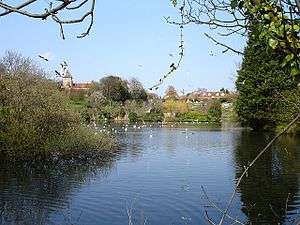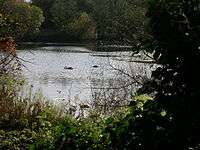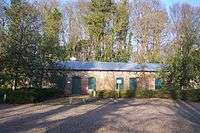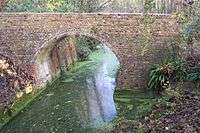Faversham explosives industry
The Faversham explosives industry: Faversham, in Kent, England, has claims to be the cradle of the UK's explosives industry: it was also to become one of its main centres. The first gunpowder plant in the UK was established in the 16th century, possibly at the instigation of Faversham Abbey. With their estates and endowments, monasteries were keen to invest in promising technology.[1]

Faversham was well-placed. It had a stream which could be dammed at intervals to provide power for watermills. On its outskirts were low-lying areas ideal for the culture of alder and willow to provide charcoal — one of the three key gunpowder ingredients. The stream fed into a tidal creek where sulphur, another key ingredient, could be imported, and the finished product loaded for dispatch to Thames-side magazines. The port was also near the Continent where in warfare demand for gunpowder was brisk.
Gunpowder
The first factories

The first factories were small, near the town, and alongside the stream, between the London to Dover road (now the A2 road) and the head of the creek. By the early 18th century, these had coalesced into a single plant, subsequently known as the Home Works, as it was the town’s first.
At this time the British government was buying its supplies from the private sector; but the quality was often poor, and in 1759 it decided it needed its own plant. Rather than build a new one, it nationalised the Home Works, upgrading all the machinery. From this phase dates the Chart Gunpowder Mill, the oldest of its kind in the world (at grid reference TR009612). It was rescued from the bulldozer's blade, and then restored by the Faversham Society in 1966. (It is now open to the public on weekend and bank holiday afternoons from April until the end of October.)
Nearby is Stonebridge Pond, today a picturesque beauty spot at the head of the creek. It served to power some of the works’ watermills, slender remains of which survive. It still features a network of narrow-gauge canals along which powder was punted from process to process.
Expansion
In the 1680s a second factory was started by Huguenot asylum-seekers alongside another stream about two kilometres west of the town (at grid reference TR001623). It had its own access to the sea via Oare Creek and so became known as the Oare Works, although it was wholly in the parish of Davington. It became a leading supplier to the British East India Company and it could be argued that without its product English would not have become the lingua franca of India, Pakistan and Bangladesh.
Gunpowder from Faversham was not just used in warfare. It played a key part in the Industrial Revolution, by enabling routes to be blasted for canals and railways.
The third and last gunpowder factory to open was the Marsh Works (at grid reference TR013626), built by the British government one km northwest of the town to augment output at its Home Works; it opened in 1787. It also had access to the sea via Oare Creek.
In the wake of the Napoleonic Wars, the government leased its Faversham works back to the private sector - the Home Works in 1816 and the Marsh Works in 1834 - selling them in 1825 and 1854 respectively. Explosives manufacture continued unabated at both sites under private ownership.
Closure
All three gunpowder factories shut in 1934. Imperial Chemical Industries (ICI), then the owners, sensed that war might break out with Germany, and realised that Faversham would then become vulnerable to air attack or possibly invasion. They transferred production, together with key staff and machinery, to Ardeer in Ayrshire, Scotland.
The sites today
The Marsh Works became a site for mineral extraction, as it remains today, and almost all its buildings were destroyed. Except for Chart Mill, Stonebridge Pond, and a few other buildings, most of the Home Works site was redeveloped for housing in the 1960s.
The Oare Works is now an attractive country park, open to the public free of charge all year round. Remains of process houses have been conserved. From an informative visitor centre, signed trails radiate in various directions. An early 20th century electric-powered gunpowder mill, which was transferred to Ardeer in 1934, has been repatriated and is on display. The 18th-century works bell has also been re-deployed and is on display at Faversham's Fleur de Lis Heritage Centre.
With their streams, watermills and forest trees planted to minimise blast damage in the event of an accident, all traditional gunpowder factories were places of beauty, even during their working lives; this one is no exception.
| Oare Gunpowder Works Country Park | ||||||||||
|---|---|---|---|---|---|---|---|---|---|---|
|
Guncotton
Gunpowder is a low explosive, best used as a propellant. Guncotton, the first high explosive, more useful for its destructive powers, was invented by Dr Christian Schonbein, of the University of Basel, in 1846. Under licence from him, it was first manufactured at Faversham’s Marsh Works in 1847.
1847 Explosion
The manufacturing process was not yet fully understood. On 14 July 1847 a serious explosion killed 18 staff, only 10 of whose bodies could be identified. As a result of the blast, the factory owners shut the plant.
New factory
Guncotton was not made again in Faversham until 1873, when the Cotton Powder Company, independent of the gunpowder factories, opened a new plant on a remote site near Uplees, about four km northwest of the town centre. It was still within the parish, but alongside the River Swale, the deep-water channel that divides mainland Kent from the Isle of Sheppey. Deliveries of raw materials — cotton waste and sulphuric and nitric acids — could readily be made, and the product was easily dispatched by water.

With a buoyant market, the factory rapidly expanded, producing each new high explosive as it was formulated. Adjoining it to the west in 1913 an associate venture, the Explosives Loading Company, built a plant to fill bombs and shells. Both plants were high-tech state-of-the-art, with a power station, hydraulic mains and an internal telephone and tramway systems. Together they occupied an area of 500 acres (two km²) — almost as large as that of the City of London.
World War I
When the First World War started in 1914, the two factories were requisitioned by the Admiralty and armed guards were mounted. Production facilities were further expanded and many new staff recruited from Faversham and elsewhere in East Kent. Road access for the workers was poor, so the Admiralty built a metre-gauge railway, the Davington Light Railway, to transport them from a terminus at Davington, near the Home Works, to Uplees.
The owners of both Swale-side factories had foreseen that they would become superfluous at the end of the First World War, and they closed promptly and permanently in 1919. The Davington light railway track was lifted; its three steam locomotives found new homes in South America, where at least one is thought to survive.
The Great Explosion
The 1916 explosion at Faversham was the worst in the history of the British explosives industry. At 14:20 on Sunday 2 April 1916, a huge explosion ripped through the gunpowder mill at Uplees, near Faversham, when a store of 200 tons of Trinitrotoluene (TNT) was detonated following some empty sacks catching fire. The TNT and ammonium nitrate (used to manufacture amatol) had exploded. The weather might have contributed to the start of the fire. The previous month had been wet but had ended with a short dry spell so that by that weekend the weather was "glorious" ... providing perfect conditions for heat-generated combustion.[2]

As it was a Sunday, no women were at work. There were 115 deaths of men and boys, including all the Works Fire Brigade, in the explosion and in subsequent sympathetic detonations. The bodies of seven victims were never found; 108 corpses were buried in a mass grave at Faversham Cemetery on 6 April.
The munitions factory was in a remote spot in the middle of the open marshes of North Kent, next to the Thames coastline, hence the explosion was heard across the Thames estuary and as far away as Norwich and Great Yarmouth. In Southend-on-Sea domestic windows and two large plate-glass shop windows were broken.
The East Kent Gazette published in Sittingbourne, did not report the explosion until 29 April. Although recognising the need for some censorship, it referred to the reply given in Parliament to an appropriate question as "mystifying and ambiguous" and called for the fullest precautions to be implemented to "prevent another calamity of the kind" occurring again.
Although not the first such disaster at Faversham’s historic munitions works, the April 1916 blast is recorded as "the worst ever in the history of the UK explosives industry", and yet the full picture is still somewhat confused. The reason for the fire is uncertain. And considering the quantity of explosive chemicals stored at the works — with one report indicating that a further 3,000 tons remained in nearby sheds unaffected — it is remarkable, and a tribute to those who struggled against the fire that so much of the nation's munitions were prevented from contributing further to the catastrophe.
The Secretary of State for War, Earl Kitchener, had written to the management of the CPC in 1914, and it is presumed the ELC, informing the workforce on: "the importance of the government work upon which they [were] engaged ..... I should like all engaged by your company to know that it is fully recognised that they, in carrying out the great work of supplying munitions of war, are doing their duty for their King and Country, equally with those who have joined the Army for active service in the field".
The Abbey works
This however, was not quite the end of high explosives manufacture in Faversham. In 1924 a new venture, the Mining Explosives Company, opened a factory on the east side of Faversham Creek, not far from the site of Faversham Abbey — hence its 'Abbey Works' name.
Its Mexco (short for Mining Explosives Company) telegraphic address led to it being known as The Mexico by local people. After a fatal accident in 1939 the proprietors decided to abandon the manufacture of high explosives and instead make an explosive-substitute based on a large reusable steel cartridge filled with carbon dioxide. The premises still needed to be licensed under the 1875 Explosives Act, as gunpowder was used in the detonator.
Under the name Long Airdox, production continues today. Unusually, the company is owned by its main customers. Its appearance is still that of a traditional high explosive factory, with no large buildings, but many small ones widely spaced for safety. It boasts one of the UK's few surviving 'manumotive' railways.
See also
- Ballincollig Royal Gunpowder Mills
- Davington Light Railway
- Gunpowder
- Gunpowder Magazines in England
- Eleutherian Mills
- Waltham Abbey Royal Gunpowder Mills
- List of the largest artificial non-nuclear explosions
References
- ↑ http://www.kentfind.co.uk/about/faversham/history.php
- ↑ "Tales of horror and heroism after the Great Explosion". Faversham Times. 30 March 2012. Retrieved 8 April 2014.
Further reading
- The Great Explosion at Faversham by Arthur Percival: also reprinted in Archaeologia Cantiana Vol. C. (1985).
- Faversham Times
- East Kent Gazette
- The Faversham Gunpowder Industry and its Development, by Arthur Percival (Faversham Papers No 4)
- Oare Gunpowder Works, by Wayne Cocroft (Faversham Papers No 39)
- Gunpowder Manufacture at Faversham: Oare and Marsh Factories, by Edward Patterson (Faversham Papers No 42)
- Faversham Gunpowder Personnel Register 1573-1840, by Raymond Godfrey & Arthur Percival (Faversham Papers No 84)
- Faversham Explosives Personnel Register 1841-1934, by John Breeze (2008)
External links
- Oare Gunpowder Works Country Park
- Faversham Online site
- Faversham Gunpowder Mill showing burial plot and list of dead
- Chart Gunpowder Mill page at The Faversham Society
Coordinates: 51°20′N 0°53′E / 51.333°N 0.883°E



%2C_Oare_Gunpowder_Works_-_geograph.org.uk_-_1621613.jpg)
